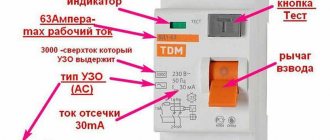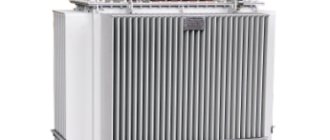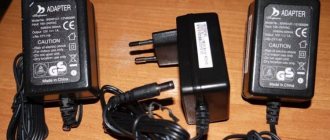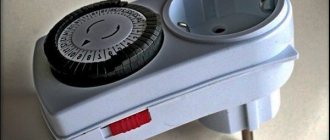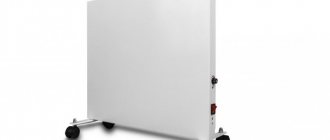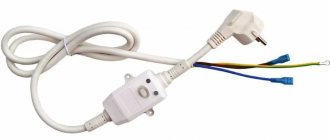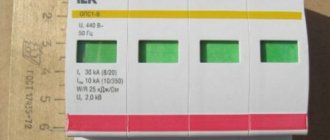What function do residual current devices perform?
Its use can save you from electric shock, prevent fire if the contacts are not of very good quality, the insulation is damaged, or there are other problems in the wiring. For this reason, there is no need to ignore the installation of an RCD.
Differential current switches (VDT) are those machines that are placed in front of the RCD, in accordance with GOST 51326.1-99. In England - RCCD's, in France - ID.
Boiler stabilizer
This is the simplest and most cost-effective option for protection against power surges. A stabilizer is purchased, most often relay (step adjustment), hung on the wall (there are floor-mounted ones) next to the boiler, the stabilizer itself is plugged into an outlet, and the boiler is plugged into an outlet on its body. All. What models are the most popular now?
Resanta LUX ASN-1000N/1-C
— relay model with a power of 1 kVA (~700 W), operating range 140 - 260 V, error 8%, there is protection against short circuit, overheating, overvoltage, and interference (Fig. 1).
Price approximately 3,000 rubles.
, example →
Bastion TEPLOCOM ST-888
- relay, power 888 VA (~620 W), operating range 145 - 260 V, error 10% (Fig. 1), price approximately
4,700 rubles.
Rucelf BOILER-1200
- relay, power 1.2 kVA (~840 W), operating range 150 - 250 V, error 8% (Fig. 1), price approximately
4,500 rubles.
, example →
Energy ARS-1000
- relay, power 1 kVA (~700 W), operating range 140 - 260 V, error 4% (Fig. 1), price approximately
5,200 rubles.
, example →
Fig.1. The appearance of the stabilizers Resanta LUX ASN-1000N/1-C, Energy ARS-1000, Bastion TEPLOCOM ST-888 and Rucelf KOTYOL-1200 differs significantly, the filling of the devices is not so much, but also different.
Fig.1-a. Energia ARS-1000 has a special pin for correct connection of phase-dependent boilers (polarity protection).
Note
.
ExpertKotel.ru does not recommend stabilizers and UPSs with a capacity below 500 VA, especially for double-circuit boilers. When the voltage drops, the output power of the stabilizer or UPS also decreases, for example, the Resanta LUX ASN-1000N/1-Ts
will output ~350 W (~50% of the nominal) when the voltage drops to 140 volts. If the total load power is higher than what the stabilizer is currently producing, it will turn off and turn off the boiler. Therefore, it is better to take into account the reserve in case of voltage drop, the optimal power is 1 kVA, 1.5 kVA or 2 kVA. This also applies to UPS.
How many phases can the equipment have?
There is a single-phase ouzo or a three-phase ouzo . Everything is simple here. If the network has only one phase, then the RCD should be single-phase (1 phase and zero). In situations where the network has three phases, then, naturally, the residual current device should be used with three phases (zero and 2 phases).
You also need to know that today they mainly use three-phase networks, the power of which is 15 kW. In order to provide good protection against fire or electric shock, a three-phase protective device is connected. This is highly discouraged, due to the fact that if the RCD is turned off, all three phases are blocked, even when only one has an electricity leak. But for boilers, electric stoves, hobs and other equipment installed in private homes, it is best to use a three-phase RCD.
Electrical connection of a gas device
Modern gas boilers have two options for connecting to the electrical network: a three-core insulated cable and a plug for connecting to a socket. In both cases, you should adhere to the rule: the gas device is connected through an individual circuit breaker to the switchboard and you will definitely need to take care of grounding. It is recommended to use voltage stabilizers as well as backup power supplies to prepare for a power outage.
The circuit breaker should be installed near the boiler so that it can be turned off quickly and easily. Do not ground the device to a heating pipe or gas pipeline. In order to ensure high-quality grounding, it is necessary to equip a grounding loop or point grounding.
How does an RCD work: principle of operation
The operation of the device is based on a comparison of the magnitude of electricity passing through it, in other words, the amount of electricity passing through this device to the consumer is equal to the magnitude of the current exiting through the neutral conductor of the device. As can be seen in the figure, I1 goes to the device that receives electricity, and I2 goes from it. If the electrical wiring is done correctly, there are no violations, I1 and I2 are equal to each other, nothing disrupts their operation.
Let's look at the simplest example. When a person touches a conductor (zero or phase), part of the electricity I∆n will transfer to it, which, in turn, will cause I1 not to be equal to I2, due to the fact that I1 > I2 – I∆n. The residual current device is highly sensitive to this, so it will immediately turn off, and the person will be protected from electric shock. The device should work very quickly, in a matter of seconds. The electric current, which manages to pass through the entire body in such a short time, has minimal strength, which is not fatal.
How to connect a gas double-circuit boiler
A double-circuit device differs from a single-circuit device in that it contains 2 heat exchangers: one is the main one, which heats the water for heating, and the other is an additional one, which will heat the water for hot water supply. In most cases, such boilers are wall-mounted and represent a high-tech boiler room, where everything is automated and provided for.
Connecting a double-circuit gas boiler.
You should pay attention to the picture, which shows the insides of a dual-circuit device. 5 pipes will be connected to it: 1 - a pipe with coolant from the heating system, which goes for additional heating; 2 - a pipe with cold water going to the heat exchanger in order to heat water for hot water supply; 3 - gas pipe; 4 - pipe for hot water supply; 5 - pipe with hot coolant for the heating system
All automation of double-circuit boilers is installed inside. The default coolant, which is heated by the main burner in the boiler, is sent to the heating system and returned to the boiler cooled down. In this way, the boiler-heating-boiler circulation occurs. However, as soon as someone opens the tap on one of the hot water consumers, cold water will begin to flow into the boiler through the pipe. The three-way valve will immediately redirect the coolant, which will not go beyond the boiler, but circulates the main heat exchanger. The coolant will heat water for domestic hot water until it is no longer used. As soon as the tap is closed, the coolant begins to circulate through the heating system.
Direct connection diagram for a gas double-circuit boiler.
In practice, a double-circuit gas appliance is not capable of providing a large amount of water for hot water supply. The boiler does not have time to heat it to the required volume. That is why they are used exclusively in small families, and in order to heat a larger volume of water, a water heater is additionally used.
According to this scheme, the coolant only heats the water in the boiler, and the system itself supplying water to the 2nd circuit will be closed. This allows you to significantly increase the durability of the dual-circuit device, which suffers greatly from tap hard water.
Connection diagram for a gas double-circuit boiler with an indirect heating water heater.
After about a year, the additional heat exchanger for domestic hot water will become clogged and fail. In this regard, the circulation of clean coolant in the 2nd circuit is a more economical solution. However, there is no point in using a dual-circuit design. In this case, it is much more profitable and practical to install a single-circuit boiler of higher power.
Connecting a gas wall-mounted boiler paired with an ordinary electric boiler as a storage tank for hot water is also acceptable. In this case, hot water will flow into the boiler from the boiler, and when its quantity decreases to a critical point, the boiler will again begin to heat the water in order to fill the boiler. An option is possible in which the boiler is filled with hot water from the boiler, and its further temperature will be maintained using a heating element.
Varieties by rated current
The most popular are modular devices from the ABB and Schneider Electric brands. There are possible types of rated electricity, which indicates its value that can pass an infinite number of times through the device: 16, 25, 40, 63 A. Therefore, the choice of device should be based precisely on these values of rated electricity.
There is no device that could provide 100% protection against overcurrents (short circuit, network overload), and this must be understood. That is why it is important that all RCDs are supplied with a circuit breaker with a rated current of less or the same strength. This is what the rules say, but I consider it advisable to install the RCD and the machine in such a way that the device has a larger rated current.
I will try to explain such “violations” of the rules in more detail. It is known that the machine can transmit electricity from 1 norm to 1.13 for a very long time, and only for an hour - 1.13-1.45. So, for example, if both the machine and the RCD are 25 A, the device transmits electricity in the amount of 36 A (25 * 1.45) per hour. Most likely, the device will simply burn out.
The rated electricity value can be found on the front of the device.
Well-known brands produce devices with the ratings indicated above, but Chinese manufacturers can produce 32 or 50A RCDs.
Cost of specialist work
Prices for assembly, installation and connection of the grounding loop depend on the specialist or company, region, and type of soil on the site. In Moscow and the Moscow region, the cost of work is about 4,500-6,000 rubles, in St. Petersburg - 3,900-5,500 rubles, in the regions - on average from 3,000 to 4,000 rubles. Please note that the price does not include the price of the grounding kit (another 6-10 thousand).
Most companies carry out turnkey installation and indicate prices taking into account the cost of the finished grounding kit.
Gas boilersInstructionsBoilers
Rated breaking current is the most important criterion for RCDs
This criterion shows the amount of current when the device is turned off. It is designated as I∆n (setpoint), it can be: 10, 30, 100, 300, and also 500 mA. There is no way for a person to open his hands to remove the cable when the network voltage is 30 mA or more. Therefore, it is better to opt for 10 or 30 mA devices, which will make it possible to protect yourself from possible electric shock.
Ahead on any device you can find the value of I∆n.
A 10 mA device is used to reliably protect electricity receivers in rooms where the humidity level is characterized as high (bathroom, toilet, etc.), as follows from SP 31-110-2003 (clause A.4.15). Can also be used for dishwashers and washing machines, providing electricity to bathrooms, toilets, balconies or loggias, and heated floors.
If we talk about 30 mA devices, then it is better to install them if the lines of the kitchen, bathroom, restroom or corridor are separated. Simply put, it is better to install a 10 mA RCD on another cable, which is used for a separate unit of household appliances, for example, a dishwasher. If one cable also powers an outlet in another room, then it is better to install a 30 mA RCD. In rooms, a 30 mA RCD is most often used to organize light and sockets.
The ABB company produces RCDs only for 10 mA, and such popular brands as Schneider Electric and Hager produce 25/10 mA and 16/10 mA.
Residual current devices for 100, 300, and 500 mA are fire protection type RCDs. Of course, in cases where the shock of electricity is so strong that it is fatal, it will not save, but if a fire occurs due to faulty wiring, it is capable. The installation location of the device is the beginning of the line.
In electrical networks where plug-type sockets are powered, according to the PUE (clause 7.1.79), it is better to install an RCD of 30 mA and no more. It is possible to connect several groups of lines to one device using separate safety elements.
In America, only 6 mA RCDs can be used, and in Europe - up to 30 mA. So, if the device is set to 30 mA, it is important that it operates at 15-30 mA, in other words, the protective device will trip at 50-100% setting.
There are developers who use differentiated methods to protect the washing machine and other energy consumers. So, for example, the machine is connected to a 16/10 mA device, and it itself is connected to a 40/30 mA group device.
In such a situation, even with a very slight malfunction in the operation of the machine, all automation (lighting, boiler) turns off. In most cases, it is almost impossible to determine whether one or both RCDs will turn off at once.
When an RCD is installed, in accordance with SP 31-110-2003 (clause A.4.2), when drawing up a design for electrical installations in residential and public buildings, it is important that the selectivity requirements are clearly and consistently observed. If the circuit contains two or more stages, the settings of the operating current and its time for protective shutdown devices near the power source must be at least three times greater than for the device that is near the electricity consumer.
Electrical wiring carried out in compliance with all the rules will prevent RCDs from tripping for several years.
Frequent errors, installation and connection rules
- room temperature
It is also advisable to warm up the room where the power source and its battery are located to temperatures from 18 to 25 degrees. Otherwise, this will all affect the battery capacity and its service life.
Also, if it is not maintained at a constant temperature, then changes in “hot-cold” can contribute to the appearance of condensation inside the equipment.
Don't forget about the cooling vents on the inverter.
- all electrical appliances should be kept as far as possible from gas and water pipes
And even more so, there is no need to place them under valves or any connecting joints and couplings.
- be sure to use a grounded socket, or ground the device body itself through a separate screw
A UPS is actually an active filter for an external network signal. Through it, excess potential can be discharged to the ground.
- It is not recommended to place the UPS and batteries directly on the floor
Make some kind of backing. At least put it on a stool.
Firstly, it will provide insulation from the cold base. Secondly, it will protect the equipment from possible leaks in the water supply system.
- Parallel connection of source and network is prohibited
Only series connection of inverter and consumer is allowed.
- You cannot charge the battery from an external charger if it is currently connected to the UPS
Types of RCD triggering
According to this criterion, there are electronic and electromechanical devices. The first option will be cheaper in price, which can be explained by a cheaper production process, however, the reliability of such devices is lower. The power of the first option comes from the network, and the quality of its functioning is determined by the parameters and quality of the electrical network.
Let's look at this in more detail using a simple example. The zero phase burned out in the electrical panel on the floor of a building on several floors; accordingly, the electronic type device will turn off and be inoperative (it needs power to work). If a short circuit occurs and someone touches it, the device will not respond. Electronics may also break down, especially if the Chinese device is of poor quality.
As for the second version of devices, they can be characterized as more reliable; they are not influenced by the state of the network. It is for this reason that it is optimal to use them.
Their work is based on comparing the electricity that leaves and enters the device. The device will turn off if the electricity is unequal to the setpoint or greater than it.
These diagrams allow you to understand which version of the device: electronic or electromechanical. The operation diagram is applied on the front side of the device body.
ABB, Schneider Electric, Hager, Legrand and other well-known manufacturers produce exclusively electromechanical devices, which is why they have been able to earn a reputation as manufacturers of RCDs of the highest quality and reliability.
The following picture shows a cross-section of electronic and electromechanical devices, which makes it possible to compare them from the inside. An example of an electronic device made in China, because, as already mentioned, well-known brands produce exclusively electromechanical RCDs.
Connecting a gas boiler to the chimney
The diameter of the chimney must be equal to or greater than the diameter of the outlet pipe in the device.
In most cases, the diameter of the chimney depends on the power:
- 100 kW - 230 mm;
- 80 kW - 220 mm;
- 60 kW - 190 mm;
- 40 kW - 170 mm;
- 30 kW - 130 mm;
- 24 kW - 120 mm.
Ordinary chimneys go up, 0.5 m above the ridge of the house. They are installed both inside the wall of the house, and inside the house or behind its wall. No more than 3 bends are allowed on the pipe. The first section of the pipe, which connects the boiler to the main chimney, must be no more than 25 cm. The pipe must have a closable hole for cleaning. Boilers with ordinary chimneys and an open combustion chamber require a large air flow. It can be provided either with an open window or with a separate supply pipe.
The chimney must be made of roofing sheet or other material that is resistant to acids. Do not connect the boiler with corrugation to the main chimney. A brick chimney cannot be used either.
The coaxial chimney must be mounted horizontally and discharged into the wall. This type of chimney is a pipe within a pipe. It should extend from the wall at least 0.5 m. If the boiler is ordinary, then the chimney pipe should have a slight slope towards the street. If the device is condensing, then the tilt should be towards the device itself. This way, the condensate will be able to drain into a special pipe, which will need to be diverted to the sewer. The maximum length of coaxial chimneys is 5 m.
Existing types of RCDs
Electricity leakage in the network determines the existing types of devices. So, for example, when there is alternating current, RCDs of one type are switched off, while others are switched off when the current is alternating and pulsating.
AC-type RCDs will turn off when there is an instantaneous alternating current leak (lighting, convectors, refrigerator, heated floor, etc.). The icon on the front indicates AC type. This type can also be designated “AS” or two designations at once.
An A-type RCD is simultaneously sensitive to alternating and pulsating electricity leakage; it can occur instantly or slowly increase. In modern washing machines and dishwashers, PCs, TVs, microwaves and other electronically controlled household appliances, rectifiers and switching power supplies are used. There are modern household appliances that use A-type protective devices.
- designation of this type of ouzo.
It is also necessary to emphasize that the protection zone of the A-type is higher than that of the AC type, which determines their higher cost. However, if it is not possible to install an A-type RCD, it is better to at least have an AC one. This will provide at least minimal protection.
PUE 7.1.78 does not prohibit the use of devices AC (they are sensitive to alternating current leakage) and A (they react to alternating and sensitive fault currents). Examples of pulsating electricity include computer equipment, televisions, dishwashers, light sources that can be regulated, etc.
To better understand which type of RCD is optimal for a specific household appliance, you should first carefully read the instructions for its use. As a rule, manufacturers provide recommendations.
AC-type devices are prohibited from being used in Europe, only A-type RCDs. B-type RCDs are extremely rarely used in the Russian Federation. An example of a place for using these RCDs would be industrial enterprises where leaks of rectified electricity occur, etc. B-type equipment is not used in everyday life.
Do I need to ground a gas heating boiler and why?
- Automation breakdown - boilers equipped with an electronic microprocessor are sensitive to any power surges in the network. The automation can also fail due to static voltage. A gas boiler without grounding will not work for long. Replacing the automation board will cost approximately half the cost of boiler equipment.
- Explosion hazard – accumulated static voltage is one of the most common causes of fire in gas equipment. The positive effect of grounding on the operation of the boiler is that the occurrence of a spark, leading to an explosion due to a gas leak, is completely prevented.
PUE 1.7.103 specifies the parameters and requirements for connecting heating equipment. Before issuing a grounding inspection certificate for a gas boiler, the inspector will check that the installation of the circuit complies with the specified standards.
Types of devices depending on when they are turned off
Devices, depending on the time that is maintained before they operate, exist in the following types:
- there is no holding time. The purpose of devices of this type is to perform a protective function against electric shock or fire in the event of wiring failures. RCDs of this type are the primary protection; they are most often installed on the lines of power receivers;
- fireproof or S-type. They turn off in 0.2-0.5 s. It can only protect against fire, but not against injury or electric shock. Such a device is placed near the input machine only at the beginning of the line. Provides a second degree of fire protection, connects automation in the electrical panel and protects the input cable. Selectivity is indicated by the presence of the “S” designation on the front side of the device.
Below you can see examples of a fire protection RCD for one phase at 100 mA from the manufacturer ABB and for 3 phases and 300 mA from the manufacturer Schneider Electric.
The leakage rating of an S-type RCD can range from 100 to 300 mA. They provide second degree protection. Existing installation requirements stipulate that the degree of response time delay and the electricity setting, if several RCDs are installed on the same line, for each subsequent installation exceed the previous one.
When RCDs are installed, in accordance with SP 31-110-2003 (clause A.4.2), all selectivity requirements must be strictly observed. When the RCD circuit is two- and multi-stage, devices near power sources should have a higher response time and response current setting than those located near electricity consumers.
If there is a power leak and there is no time delay, and there are two devices on the line (30 and 100 mA), they would trip together, and the most powerful RCD in the entire building would turn off the electricity. It follows that you need to choose a fire-fighting device that is installed in an outdoor electrical panel to ensure high-quality fire protection.
There are also G-type RCDs. It is similar to the one described above, but its exposure time is 0.06-0.08 s. This is a pretty rare type. Having ordered such a device, you have to wait several months for it, which causes certain inconvenience.
Piping a gas boiler in the heating system
After the wall-mounted gas boiler has been installed and the heating device is placed on the wall, the first thing you need to do is connect it to the heating system. Depending on which model is installed, single-circuit or double-circuit, there are different piping schemes. We will look at the connection process using the example of a wall-mounted double-circuit gas boiler.
As you know, a double-circuit boiler, in addition to heating, is capable of producing hot water for household needs. Structurally, this is realized by installing one bithermal or two separate heat exchangers. A double-circuit boiler does not produce very much hot water, but it is quite enough for 1-2 distribution points (for example, a kitchen faucet and shower).
A modern wall-mounted gas boiler is very compact and already contains within itself the basic elements necessary for the operation of a heating system with forced circulation, such as: a circulation pump, an expansion tank, a safety group. In the heating systems of small private country houses, this is more than enough, but if necessary, you can install an additional expansion tank or another pump.
At the bottom of any mounted double-circuit boiler there are 5 pipes. They are connected to: supply and return lines of the heating system, supply and return of hot water supply, main gas. The gas connection is usually located in the center and is colored yellow. All other lines can be located in any order, depending on the model of the gas boiler. Therefore, before starting tying, it is necessary to clarify the purpose of each of them in the operating instructions.
The piping of a wall-mounted gas boiler is done with polypropylene or metal pipes. The cross-section of heating pipes is usually larger than DHW pipes 3/4 and 1/2 inches, respectively. The heating system is connected to the boiler through American nuts. Ball valves are installed on each line for the convenience of dismantling the gas boiler without draining the coolant and to isolate the boiler from the heating system if necessary. To ensure tightness, all connections must be made using plumbing FUM tape or flax.
Coarse filters must be installed in the heating return line and in the DHW supply line. For ease of washing and cleaning, they are also cut off by shut-off valves. Often, in order to increase the service life of the secondary heat exchanger of a double-circuit boiler, a magnetic fine filter is additionally installed at the DHW supply.
